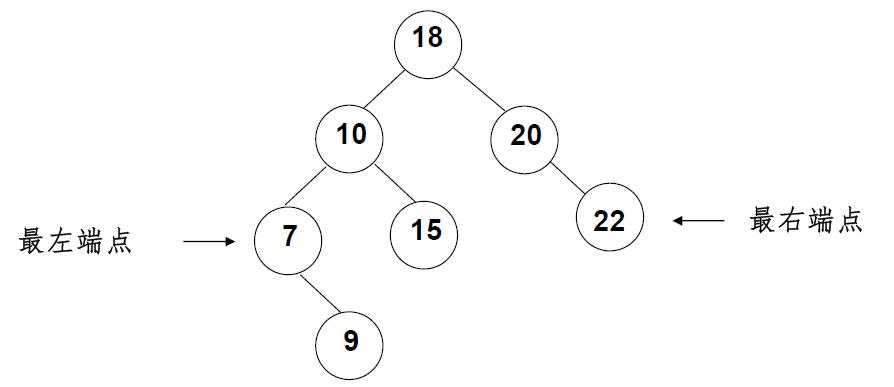二叉搜索树(BST,Binary Search Tree),也称二叉排序树或二叉查找树。
二叉搜索树:一棵二叉树,可以为空;如果不为空,满足以下性质:
- 非空左子树的所有键值小于其根结点的键值;
- 非空右子树的所有键值大于其根结点的键值;
- 左右子树都是二叉搜索树;

- The left subtree of a node contains only nodes with keys less than the node's key.
- The right subtree of a node contains only nodes with keys greater than the node's key.
- The left and right subtrees each must also be a binary search tree.
- Each node can have up to two successor nodes.
- There must be no duplicate nodes.
- A unique path exists from the root to every other node.
二叉搜索树操作的特别函数:
Position Find(ElementType X,BinTree BST):从二叉搜索树BST查找元素X,返回其所在结点的地址;
Position FindMin(BinTree BST):从二叉搜索树BST中查找并返回最小元素所在结点的地址;
Position FindMax(BinTree BST):从二叉搜索树BST中查找并返回最大元素所在结点的地址;
BinTree Insert(ElementType X,BinTree BST):把元素X结点插入到二叉搜索树BST中;
BinTree Delete(ElementType X,BinTree BST):从二叉搜索树BST中删除元素X结点;
【二叉搜索树的查找操作:Find】
1、查找从根结点开始,如果树为空,返回NULL;
2、若搜索树非空,则根结点关键字和X进行比较,并进行不同处理:
- 如果X小于根结点的键值,只需在左子树中继续搜索;
- 如果X大于根结点的键值,只需在右子树中继续搜索;
- 若两者比较结果是相等,搜索完成,返回指向此结点的指针;
递归查找操作:
1 Position BST_Find(ElementType X, BinTree BST)
2 {
3 if(BST == NULL)
4 return NULL;
5
6 if(X > BST->Data)
7 return BST_Find(X, BST->Right);
8 else if(X < BST->Data)
9 return BST_Find(X, BST->Left);
10 else
11 return BST;
12 }
非递归查找操作:
1 Postion BST_Find_ext(ElementType X, BinTree BST)
2 {
3 while(BST != NULL)
4 {
5 if(X > BST->Data)
6 BST = BST->Right;
7 else if(X < BST->Data)
8 BST = BST->Left;
9 else
10 return BST;
11 }
12 return NULL;
13 }
【二叉搜索树查找最大元素FindMax和最小元素FindMin】
最大元素一定是在树的最右分支的端结点上;
最小元素一定是在树的最左分支的端结点上;

递归查找Min和Max:
1 Position BST_FindMin(BinTree BST)
2 {
3 if(BST == NULL)
4 return NULL;
5 else if(BST->Left == NULL)
6 return BST;
7 else
8 return BST_FindMin(BST->Left);
9 }
10
11 Position BST_FindMax(BinTree BST)
12 {
13 if(BST == NULL)
14 return NULL;
15 else if(BST->Right == NULL)
16 return BST;
17 else
18 return BST_FindMax(BST->Right);
19 }
非递归查找Min和Max:
1 Position BST_FindMin_ext(BinTree BST)
2 {
3 if(BST != NULL)
4 {
5 while(BST->Left != NULL)
6 BST = BST->Left;
7 }
8 return BST;
9 }
10
11 Position BST_FindMax_ext(BinTree BST)
12 {
13 if(BST != NULL)
14 {
15 while(BST->Right != NULL)
16 BST = BST->Right;
17 }
18 return BST;
19 }
【二叉搜索树的插入操作:Insert】
1 BinTree BST_Insert(ElementType X, BinTree BST)
2 {
3 if(BST == NULL)
4 {
5 // 若原树为空,生成并返回一个结点的二叉搜索树
6 BST = malloc(sizeof(struct TreeNode));
7 BST->Data = X;
8 BST->Left = NULL;
9 BST->Right = NULL;
10 }
11 else
12 {
13 // 开始找要插入元素的位置
14 if(X < BST->Data)
15 BST->Left = BST_Insert(X, BST->Left); // 递归插入左子树
16 else if(X > BST->Data)
17 BST->Right = BST_Insert(X, BST->Right); // 递归插入右子树
18 // else X已经存在,什么都不做
19 }
20 return BST;
21 }
【二叉搜索树的删除操作:Delete】
二叉搜索树的删除操作需要考虑三种情况:
- 要删除的是叶结点:直接删除,并修改其父结点指针置为NULL;
- 要删除的结点只有一个孩子结点:将其父结点的指针指向要删除结点的孩子结点;
- 要删除的结点有左右两棵子树:用另一个结点替代被删除结点,右子树的最小元素 或者 左子树的最大元素;
1 BinTree BST_Delete(ElementType X, BinTree BST)
2 {
3 Position Tmp;
4
5 if(BST == NULL)
6 {
7 printf("warning: xxx\n"); // 未找到要删除的元素
8 }
9 else if(X < BST->Data)
10 {
11 BST->Left = BST_Delete(X, BST->Left); // 左子树递归删除
12 }
13 else if(X > BST->Data)
14 {
15 BST->Right = BST_Delete(X, BST->Right); // 右子树递归删除
16 }
17 else
18 {
19 // 被删除结点有左右两个子结点
20 if(BST->Left != NULL && BST->Right != NULL)
21 {
22 // 在右子树中找到最小的元素填充删除结点
23 Tmp = BST_FindMin(BST->Right);
24 BST->Data = Tmp->Data;
25 // 在删除结点的右子树中删除最小元素
26 BST->Right = BST_Delete(BST->Data, BST->Right);
27 }
28 else // 被删除结点有一个或无子结点
29 {
30 Tmp = BST;
31 if(BST->Left == NULL) // 有右孩子或者无子结点
32 BST = BST->Right;
33 else if(BST->Right == NULL) // 有左孩子或者无子结点
34 BST = BST->Left;
35 free(Tmp);
36 }
37 }
38 return BST;
39 }
Wiki链接:
Binary_search_tree :http://en.wikipedia.org/wiki/Binary_search_tree
来源:https://www.cnblogs.com/utank/p/4277072.html